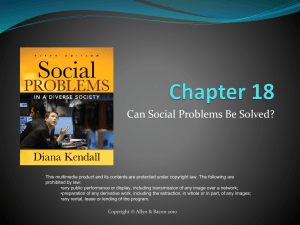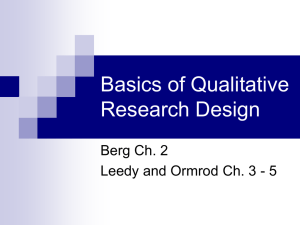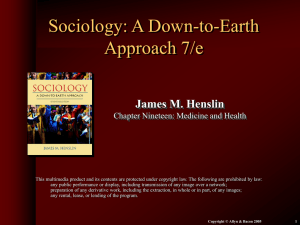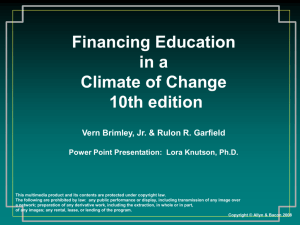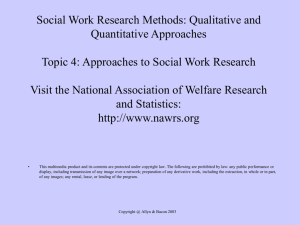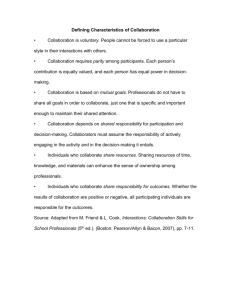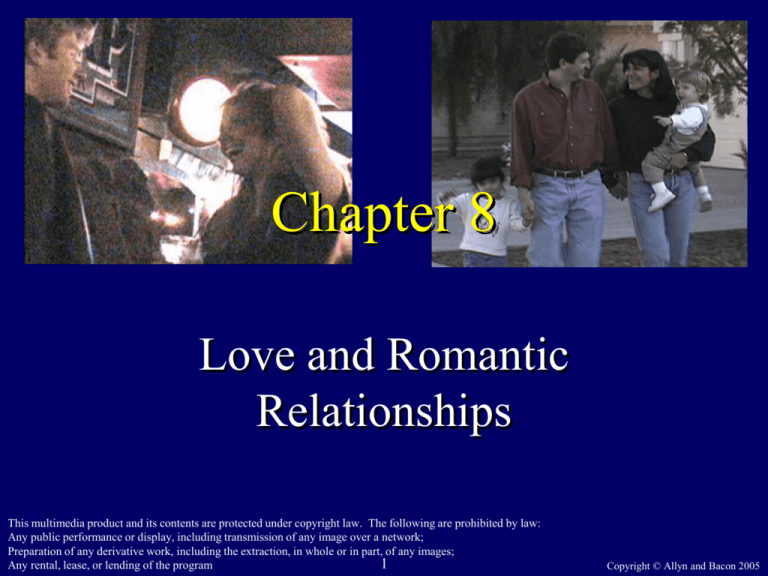
Chapter 8
Love and Romantic
Relationships
This multimedia product and its contents are protected under copyright law. The following are prohibited by law:
Any public performance or display, including transmission of any image over a network;
Preparation of any derivative work, including the extraction, in whole or in part, of any images;
1
Any rental, lease, or lending of the program
Copyright © Allyn and Bacon 2005
Have you ever had strong feelings for
another person and wondered
whether or not you were “in love?”
What do you look for in a potential
long-term partner?
Do you think men and women look for
different features in a marriage
partner?
What about a short-term partner?
2
Copyright © Allyn and Bacon 2005
Chapter Outline
The Defining Features of Love
The Goals of Romantic Relationships
Obtaining Sexual Satisfaction
Establishing Family Bonds
Gaining Resources and Social Status
Breaking Up (and Staying Together)
3
Copyright © Allyn and Bacon 2005
Defining Love and Romantic
Attraction
The Defining Features of Love
Focus on Methods: Uncovering the
Different Factors of Love
Are There Different Varieties of Love?
The Goals of Romantic Relationships
4
Copyright © Allyn and Bacon 2005
Defining Features of Love
Beverly Fehr asked Canadian students
to list as many features of love as
they could in 3 minutes.
Students’ lists commonly included:
Caring
Friendship
Trust
Euphoria
Heartrate increases
Happiness
Warmth
Commitment
Sexual passion
Etc
oo
oo
o
5
Copyright © Allyn and Bacon 2005
The long list could be reduced to
three essential components:
PASSION
physiological arousal,
longing to be with
INTIMACY
close bond, sharing,
support
COMMITMENT
willing to define as love,
commitment to long term
6
Copyright © Allyn and Bacon 2005
Sternberg’s Triangular Theory of
Love (page 257)
Passion
Intimacy
Decision/
Commitment
7
Copyright © Allyn and Bacon 2005
Factor analysis
Factor analysis –
statistical technique for sorting test
items or behaviors into conceptually
similar groupings (page 258)
Example: Factor analysis was used to
group various features of love into
passion, intimacy, and commitment.
8
Copyright © Allyn and Bacon 2005
Are There Different Varieties of
Love?
Not all types of “love” involve the same mix
of passion, intimacy, and commitment.
Passionate love –
a state of intense longing for union with
another
Companionate love –
affection and tenderness for those whose
lives are entwined with our own.
9
Copyright © Allyn and Bacon 2005
10
Copyright © Allyn and Bacon 2005
Obtaining Sexual
Satisfaction
11
Copyright © Allyn and Bacon 2005
Did you think about sex even for a
moment during the last 5 min?
When men and women under the age
of twenty-five were asked this
question, half of the men and 40%
of the women said “Yes.”
Among those 26-55: 1 in 4 men and 1
in 7 women said “Yes.”
College men and women report
several sexual fantasies per day.
12
Copyright © Allyn and Bacon 2005
Obtaining Sexual Satisfaction
Hormones
Sociosexual Attitudes
Who’s Sexually Attractive?
Gender Differences in Sexuality
Arousing Settings
Cultural Norms about Sexuality
Sexual Situations Look Different to
Men and Women
Cultural Practices May Trick Evolved
Mechanisms
13
Copyright © Allyn and Bacon 2005
Hormones
Injections of testosterone into men
with malfunctioning testes increase
sexual fantasies;
Stopping injections reduces fantasies.
Injections of testosterone also increase
sexual desire and fantasy in women.
Sexual fantasies in teenagers of both
sexes are also linked to testosterone.
14
Copyright © Allyn and Bacon 2005
Sociosexual Attitudes
Sociosexual orientation –
Individual differences in tendency to
prefer either:
Unrestricted sex (without the necessity
of love)
Restricted sex (only in the context of a
long-term, loving relationship).
15
Copyright © Allyn and Bacon 2005
Who’s Sexually Attractive?
Physically attractive individuals have
more opportunities for sexual
relationships.
College students in one study were
willing to lie about themselves to win
dates with physically attractive
partners.
16
Copyright © Allyn and Bacon 2005
What is Considered Attractive?
High bodily symmetry
Women with
Low waist-to-hip ratios
Lustrous, shiny hair
Large eyes and a small nose
Men with
Masculine features
A large jaw and a medium sized nose
17
Copyright © Allyn and Bacon 2005
Gender Differences in Sexuality
Men and women differ in their criteria
for sexual partners
But their criteria for long-term
partners are very similar.
18
Copyright © Allyn and Bacon 2005
esearch
Students in one series
of studies were asked:
What is the minimum percentile of
intelligence you would accept in
considering someone for:
A date
A sexual partner
A one night stand
A steady dating partner
A marriage partner?
Kenrick, Groth, Trost & Sadalla (1993)
19
Copyright © Allyn and Bacon 2005
Minimum Intelligence Desired
Women desire slightly above
average for a single date
50th
%ile
AVERAGE
DATE
20
Copyright © Allyn and Bacon 2005
And want more with
increasing commitment
50th
%ile
DATE
SEX
STEADY
21
MARRIAGE
Copyright © Allyn and Bacon 2005
Men have similar criteria for
dates
DATE
SEX
STEADY
22
MARRIAGE
Copyright © Allyn and Bacon 2005
And for long-term mates.
DATE
SEX
STEADY
23
MARRIAGE
Copyright © Allyn and Bacon 2005
Men’s criteria are
considerably
lower for sexual
partners
DATE
SEX
STEADY
24
MARRIAGE
Copyright © Allyn and Bacon 2005
And the differences are
even more pronounced
for one-night stands.
DATE
SEX
STEADY
25
MARRIAGE
Copyright © Allyn and Bacon 2005
These results suggest females increase
selectivity as the probability of
pregnancy increases
And males are selective for long term
relationships where they commit
resources
But will be less selective if given the
opportunity for a low investment
reproductive opportunity.
26
Copyright © Allyn and Bacon 2005
In one study, students were approached
by another student of the opposite sex,
who said:
“I have been noticing you around campus.
I find you very attractive.”
This was followed by one of three
invitations:
“Would you go out with me tonight?” or
“Would you come over to my apartment?” or
“Would you go to bed with me?”
27
Copyright © Allyn and Bacon 2005
Clark and Hatfield
esearch
Percent Saying “Yes”
100
Men were even more
likely to say “yes” to the
sexual invitation.
80
60
About half of both
sexes said “yes” to
the date.
40
20
Not a single
woman said
“yes” to the
sexual
invitation.
0
Go Out
Go to Apt.
28
Go to Bed
Copyright © Allyn and Bacon 2005
Arousing Settings
Settings that increase physiological
arousal often fuel feelings of
passion.
Why?
Several theories have been advanced
to explain this phenomenon.
29
Copyright © Allyn and Bacon 2005
Two-factor theory
According to this theory, feelings of
love consist of:
General Physiological Arousal
+
A Label For That Arousal
The theory posits that we can confuse the
specific cause of our arousal, and we may
mistake fear or anxiety for “love.”
30
Copyright © Allyn and Bacon 2005
Two-factor theory
Consistent with the theory, men report
more attraction to attractive women
they meet in various arousing
situations:
Expecting electric shock
On a shaky suspension bridge
After exercising.
31
Copyright © Allyn and Bacon 2005
Two-factor theory
Some problems with the theory:
When asked the cause of their arousal,
people expecting shock do not mistakenly
attribute it to the attractive woman.
Fear causes heterosexual students to report
more liking towards people of the same sex
(to whom they do not attribute any
passionate feelings). Remember danger
and emotional support from chapter 7
32
Copyright © Allyn and Bacon 2005
Arousal-facilitation theory
According to this theory:
It is not necessary to assume people
make mistakes about the causes of
their arousal.
Arousal is simply a burst of energy that
adds fuel to whatever fire is burning.
33
Copyright © Allyn and Bacon 2005
Arousal-facilitation theory
If you go for a run after drinking coffee,
you’ll run faster.
If you normally approach an attractive
person or likable person, you’ll
approach more enthusiastically if you
are aroused.
You’re still energized even if you know
your arousal came from a cup of coffee
or a threat of electric shock.
34
Copyright © Allyn and Bacon 2005
Arousing Settings
Obstacles to a love affair can produce
arousal, which can sometimes fan the
flames of love.
What do we desire most? Sometimes it is
what we think we may not be able to
have. Why buy the cow when the milk is
free? Periods of forced separation.
Playing “hard to get”. Jealousy over
another possible lover.
35
Copyright © Allyn and Bacon 2005
Cultural Norms
About Sexuality
Cultures vary in acceptance of premarital
sex, extramarital sex, and
appropriateness of sex without love.
Americans, on average,
Begin kissing at around age 14 or 15
Begin having intercourse around age 17.
Japanese begin kissing at around age 20.
Have intercourse at age 22 or 23.
36
Copyright © Allyn and Bacon 2005
Sexual Situations Look
Different to Men and Women
Compared to women, men perceive
more sexuality in an interaction
between a man and a woman.
This is true whether they are
participants or observers.
However, men see interactions
involving their sister as Platonic.
37
Copyright © Allyn and Bacon 2005
Nonverbal cues
Monica Moore observed women in singles’
bars and more neutral settings.
Women in singles bars used a number of
nonverbal gestures that appeared to
initiate interactions with men, including:
Head tosses
Hair flips
Eyebrow flashes
Smiles.
38
Copyright © Allyn and Bacon 2005
39
Copyright © Allyn and Bacon 2005
40
Copyright © Allyn and Bacon 2005
41
Copyright © Allyn and Bacon 2005
42
Copyright © Allyn and Bacon 2005
43
Copyright © Allyn and Bacon 2005
Cultural Practices May Trick
Evolved Mechanisms
People are usually attracted to
opposite sex neighbors (often
marrying the girl or guy next door);
“proximity-attraction principle”.
Children from kibbutz groups,
however, did not show sexual
attraction towards those raised in the
same household. Why? Page 268
44
Copyright © Allyn and Bacon 2005
Establishing Family Bonds
45
Copyright © Allyn and Bacon 2005
Establishing Family Bonds
Passionate sexual attraction fades with
time.
But feelings of intimacy and
commitment increase with time.
The loss of a spouse is one of the most
stressful of life events.
46
Copyright © Allyn and Bacon 2005
The Importance of Attachment
Need to belong –
the human need to form and
maintain strong, stable interpersonal
relationships
The same feeling that keeps a romantic
couple bonded may be what keeps
them attached to their children.
47
Copyright © Allyn and Bacon 2005
The Importance of Attachment
Three-stage pattern of separation
distress –
reaction sequence shown by infants
or adults when separated from those
to whom they are intimately
attached
48
Copyright © Allyn and Bacon 2005
The Three-stage Pattern of
Separation Distress
PROTEST
attempts to reestablish contact
DESPAIR
inactivity and
helplessness
lack of concern and
coolness towards
parent or lover
DETACHMENT
49
Copyright © Allyn and Bacon 2005
Secure Base
Secure base –
comfort provided by
attachment figure
A secure base allows
the person to venture
forth more
confidently to explore
the environment.
50
Copyright © Allyn and Bacon 2005
Bringing the male into the bond
A bond between
mother and offspring
is found in all mammals
(who nurse and care for the young).
In 95% of mammalian species the male
does not contribute to offspring care.
Humans are one of the rare exceptions.
51
Copyright © Allyn and Bacon 2005
Establishing Family Bonds
Attachment Style
Exchange/Communal Orientation
Threats
Jealousy and Same-Sex
Competitors
Relationships Change Our
Personalities
52
Copyright © Allyn and Bacon 2005
Attachment Styles
SECURE
Attachments marked by
trust that the other will
continue to provide love
and support
ANXIOUS/
AMBIVALENT
Fear of abandonment;
feeling that one’s needs
are not being met
AVOIDANT
Defensive detachment
from the other
53
Copyright © Allyn and Bacon 2005
Exchange/Communal
Orientation
Those who adopt an “exchange”
orientation calculate costs and
benefits in relationships.
Those who adopt a “communal”
orientation pay more attention to
partner’s needs.
Those with an exchange orientation
are less satisfied with marriages.
54
Copyright © Allyn and Bacon 2005
Threats
Situations that trigger fear, anxiety, or
insecurity intensify attachments.
Threats to the relationship particularly
enhance the motivation to bond
more closely. Exceptions?
55
Copyright © Allyn and Bacon 2005
Obsessive Relationships and
Unrequited Love
Erotomania –
a disorder involving the fixed (but
incorrect) belief that one is loved by
another, which persists in the face of
strong evidence to the contrary
Obsessive relationships may stem from
inappropriate activation of normal
attachment bonds.
Erotophobia – fear of intimacy
56
Copyright © Allyn and Bacon 2005
Jealousy and Same-Sex
Competitors
Imagine you discover that the person with
whom you’ve been seriously involved
has become interested in someone else.
What would distress you more?
1. Imagining your partner falling in love
and forming a deep emotional attachment
to that person.
2. Imagining your partner having sexual
intercourse with that person.
57
Copyright © Allyn and Bacon 2005
Jealousy and Same-Sex
Competitors
The majority of men reported more
distress to the sexual infidelity.
About 80 percent of the women were
more distressed over emotional
attachment.
58
Copyright © Allyn and Bacon 2005
Relationships Change Our
Personalities
Long term relationships cause people to
Change attachment styles
Overestimate their similarities to their
partner
Change their attitudes to fit with those of
their partner.
59
Copyright © Allyn and Bacon 2005
Gaining Resources and
Social Status
60
Copyright © Allyn and Bacon 2005
Gaining Resources and Social
Status
In many animal species, females
choose males who have managed to
defend the most valuable territories.
Among humans, power and status
bring access to material rewards.
Men with power and status have an
easier time attracting mates.
61
Copyright © Allyn and Bacon 2005
Gaining Resources and Social
Status
Gender and Sexual Orientation
Culture, Resources, and
Polygamy
Increasing Levels of Involvement
When Dominance Matters
62
Copyright © Allyn and Bacon 2005
Women’s Preference for Status
Women prefer a well-dressed
unattractive man to a good-looking
man in a Burger King outfit.
Opposite for men judging women
(Townsend & Levy, 1990).
Across societies women place more
emphasis on a potential mate’s
income and status (Buss, 1990).
63
Copyright © Allyn and Bacon 2005
Men’s Preference for
Reproductive Resources
Older men are attracted to relatively
younger women (Kenrick & Keefe,
1992).
Younger men are attracted to relatively
older women (Kenrick et al., 1996).
Why??????
This same pattern is found across
societies and historical periods.
64
Copyright © Allyn and Bacon 2005
Phoenix Singles Ads
Oldest preferred
Singles’ ads by young men
show no preference for
younger partners
DIFFERENCE FROM
TARGET'S AGE
20
But older men prefer
partners younger than
themselves
10
Youngest preferred
20
10
0
0
-10
-10
-20
-20
10s
20s
30s
40s
50s
MALE'S AGE
60s
Women of all ages ask for
men around their own age
or older
10s
20s
30s
40s
50s
60s
FEMALE'S AGE
Kenrick & Keefe, Behavioral & Brain Sciences, (1992).
65
Copyright © Allyn and Bacon 2005
Phoenix Singles Ads
Oldest preferred
Youngest preferred
20
10
10
0
0
-10
-10
-20
-20
DIFFERENCE FROM
TARGET'S AGE
20
10s
20s
30s
40s
50s
MALE'S AGE
60s
Marriages show a
similar pattern
10s
20s
30s
40s
50s
60s
FEMALE'S AGE
Kenrick & Keefe, Behavioral & Brain Sciences, (1992).
66
Copyright © Allyn and Bacon 2005
DIFFERENCE FROM
TARGET'S AGE
20
10
Phoenix Singles Ads
Oldest preferred
The same pattern
was found on a
remote island in
the Philippines
early in the
century
Youngest preferred
PORO - 1913 - 1929
0
-10
-20
10s 20s
30s 40s >50
10s 20s 30s 40s >50
MALE'S AGE
FEMALE'S AGE
The same pattern has also now been found in Africa,
Brazil, Japan, and numerous other societies
67
Copyright © Allyn and Bacon 2005
Are Homosexuals Different?
Homosexual men are like heterosexual men in
their
Age preferences
Emphasis on physical attractiveness
De-emphasis of status.
Homosexual women?
This suggests mate preferences aren’t a simple
“one-switch” mechanism. Page 277-8
68
Copyright © Allyn and Bacon 2005
What Happens When Women
Gain Status and Resources?
In societies where women have little
wealth in power, the desire for
wealth in a man is greater than in
societies where women are
relatively better off.
69
Copyright © Allyn and Bacon 2005
Culture, Resources,
and Polygamy
Monogamy –
marital custom in which one man
marries one woman
Polygamy –
marriage involving more than one
partner, includes polyandry and
polygyny
70
Copyright © Allyn and Bacon 2005
Culture, Resources,
and Polygamy
Polyandry –
one woman weds more than one
husband.
Polygyny –
one man weds more than one wife.
71
Copyright © Allyn and Bacon 2005
Culture, Resources,
and Polygamy
Polyandrous woman’s multiple husbands
are usually brothers who share limited
resources.
Extreme polygyny (e.g., harems) involves:
Steep social hierarchy
Great wealth in some families
Possibility of starvation for others. Page 280
72
Copyright © Allyn and Bacon 2005
Social Exchange In
Committed Relationships
Equity rule –
each person’s benefits and costs in a
social relationship should match the
other’s benefits and costs
Relationships characterized by very
positive feelings follow a needbased rule.
73
Copyright © Allyn and Bacon 2005
When Dominance Matters
Although women are initially attracted
to sex-typed dominant males, over
time less sex-typed men are easier to
get along with (Ickes, 1993).
To be attractive to a woman,
dominance must be accompanied by
agreeableness (Jensen-Campbell,
Graziano, & West, 1995).
74
Copyright © Allyn and Bacon 2005
esearch
When Dominance
Matters
Women in one study read about a man
who was either
Dominant or
Non-dominant
And either
Agreeable or
Disagreeable.
75
Copyright © Allyn and Bacon 2005
Jensen-Campbell, Graziano, & West, 1995
esearch
Nondominant
Dominant
9
Desirability
as a Date
7
5
3
1
Disagreeable
Agreeable
When the man was disagreeable, women
found him undesirable as a date,
regardless of whether he was dominant
or nondominant.
76
Copyright © Allyn and Bacon 2005
Jensen-Campbell, Graziano, & West, 1995
esearch
Nondominant
Dominant
9
Desirability
as a Date
7
5
3
1
Disagreeable
Agreeable
When he was agreeable, women found him
desirable as a date
And his desirability was enhanced if he was
also dominant.
77
Copyright © Allyn and Bacon 2005
Who’s on Top?
In a “Dating Game” experiment,
unrestricted men used more direct
competitive tactics (Simpson et al.,
1999).
Men’s self-rated marriage potential drops
after seeing socially dominant men.
Women’s drops after seeing physically
attractive women (Gutierres et al.,
1999). Page 282
78
Copyright © Allyn and Bacon 2005
Breaking Up
(and Staying Together)
Some People Are Better at
Getting Along
Some Situations Pull Couples
Apart
It Takes Two to Tango
79
Copyright © Allyn and Bacon 2005
Some People Are
Better at Getting Along
People in unstable relationships tend
to be
Unconventional and extraverted
Prone to negative moods.
80
Copyright © Allyn and Bacon 2005
Some Situations
Pull Couples Apart
Economic problems often stress
marriages.
When there is surplus of women to
men, men are less likely to commit
to marriage.
81
Copyright © Allyn and Bacon 2005
It Takes Two to Tango
Low self esteem in one partner can
cause that person to become cold
and distant, making the relationship
more costly for their partners.
People in stable relationships judge
models in magazines as less
attractive.
82
Copyright © Allyn and Bacon 2005
Factors That
Facilitate
Workplace
Romance, and
Which May
Create Stress
in Current
Relationships
83
Copyright © Allyn and Bacon 2005
Studying Healthy Communication
to Save Marriages
Markman and colleagues videotaped
happy couples and unhappy couples
as they discussed problems.
Unhappy couples responded to conflict
with “zingers” – negative statements
about their partners.
84
Copyright © Allyn and Bacon 2005
Rules of Effective
Communication
The researchers developed a
premarital training program in
effective communication.
Some of the helpful rules included:
1. Positive framing: Say “I’d enjoy
playing tennis” NOT “I don’t want
to go hang out with your boring
friends again!”
85
Copyright © Allyn and Bacon 2005
Rules of Effective
Communication
2. Express appreciation: Say “Thanks
for doing the dishes” vs. “You
missed one!”
86
Copyright © Allyn and Bacon 2005
Rules of Effective
Communication
3. Avoid silent treatment: Say
something when arriving, leaving,
or going to bed.
87
Copyright © Allyn and Bacon 2005
Rules of Effective
Communication
4. Don’t be a “psychopest.” Don’t
analyze your partner’s behavior as a
guise for being a critic. “Hmm,
that’s just like your mother’s
behavior.”
88
Copyright © Allyn and Bacon 2005
Rules of Effective
Communication
5. Speak for yourself, not your partner.
Don’t say “I know YOU’D enjoy a
movie” say “I’d really enjoy a
movie.”
89
Copyright © Allyn and Bacon 2005
Rules of Effective
Communication
6. Say it directly. Don’t say “do you
want to eat out?” when you’re
thinking “I’m dying to eat Mexican
food.”
90
Copyright © Allyn and Bacon 2005
Rules of Effective
Communication
7. Nothing nice to say? Then keep
quiet.
91
Copyright © Allyn and Bacon 2005




